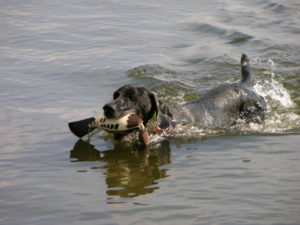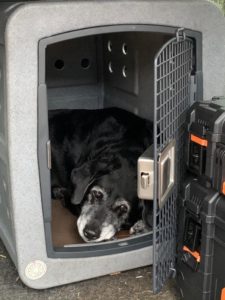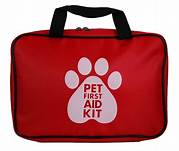An article from WWA’s Doctor’s Orders
 By Dr. K.C. Brooks, an avid waterfowler, dog lover and practicing veterinarian at Lodi Veterinary Care.
By Dr. K.C. Brooks, an avid waterfowler, dog lover and practicing veterinarian at Lodi Veterinary Care.
This article originally appeared in Wisconsin Waterfowl Association’s September, 2020 eNewsletter.
I am quite certain that dogs are much like us when it comes to practice versus the real competition. They happily comply with our training regimen most days, and even are thoroughly engrossed in it on other days. I am confident there are some days when they are thinking, “Oh no, not this drill again – how many times must we repeat what I know so well!” Game day, though, brings a whole new level of excitement for both owner and dog. Nothing beats the smell of the duck marsh, the splash of duck decoys hitting the water and the whistling of wings in the dark as you trudge back to the blind to wait for first light. No matter how you structure your training days, I am 100 percent certain that most dogs know the difference between a training day and a hunting day before you even leave the house.
 For the purposes of this article, I am going to consider our dog’s hunting season similar to that of a professional football player’s season. Initially there is the off-season, where maybe there is little done beyond rest and relaxation. For my Jojo, the off season means days of lounging around the house, chasing the occasional backyard rabbit, fetching a favorite toy and begging for food whenever possible. It is a life of leisure, and although her muscle tone and endurance may suffer a bit, she is very unlikely to suffer an injury of any sort. Next comes training camp. Much of training camp is comparable to OTAs (Organized Team Activities) – no pads, no contact and lots of repetitions. For our dogs, this is a time where they likely experience some sore muscles, sensitive pads, and maybe some aching joints depending on their age and activity level. Finally, the real season hits and the game changes dramatically. Often the drives to our hunting grounds are longer, the weather conditions more unpredictable, the environment much more unforgiving and the intensity of activity often times dramatically increased. But just like the football player, the real season carries a much higher incidence of accidents and injuries. What follows are some common sense measures which may help to minimize some of those problems.
For the purposes of this article, I am going to consider our dog’s hunting season similar to that of a professional football player’s season. Initially there is the off-season, where maybe there is little done beyond rest and relaxation. For my Jojo, the off season means days of lounging around the house, chasing the occasional backyard rabbit, fetching a favorite toy and begging for food whenever possible. It is a life of leisure, and although her muscle tone and endurance may suffer a bit, she is very unlikely to suffer an injury of any sort. Next comes training camp. Much of training camp is comparable to OTAs (Organized Team Activities) – no pads, no contact and lots of repetitions. For our dogs, this is a time where they likely experience some sore muscles, sensitive pads, and maybe some aching joints depending on their age and activity level. Finally, the real season hits and the game changes dramatically. Often the drives to our hunting grounds are longer, the weather conditions more unpredictable, the environment much more unforgiving and the intensity of activity often times dramatically increased. But just like the football player, the real season carries a much higher incidence of accidents and injuries. What follows are some common sense measures which may help to minimize some of those problems.
Transportation – Step number one in our effort to have a safe hunting day is to get to and from the hunting location safely. I highly recommend the use of a travel crate or seat belt to secure your dog in your vehicle. Ideally, that crate should be anchored in some manner and covered if it is in the back of an open pickup truck. While it is a romantic thought to have your companion seated next to you with his head out the window, the real life consequences of him exiting the vehicle through the window or windshield because of a car crash is devastating. Likewise, foreign bodies hitting his eyes at 70 mph usually lead to very bad results.
Avoiding the Avoidable – Many of the dangers our dogs face are unavoidable due to the nature of the hunting conditions. There are also several things that put our dogs at risk that we can work hard to avoid. They include: 1) Barbed wire fences – These are still common in fallow fields and flooded areas and are the source of many ugly lacerations. Being vigilant about where fences may be hidden or submerged is very important. 2) Vegetation and strong current – These can also pose a significant risk to your dog. Depending on your dog’s swimming ability and conditioning, both of these factors can result in drowning. A “driven” retriever chasing a wounded bird can very easily get themselves into trouble if you are unable to call them off if needed. Being prepared for such situations or avoiding those hunting spots is best. 3) Hyperthermia and hypothermia – Although on opposite ends of the spectrum, these can be significant risks to our hunting companion. Paying close attention to your dog’s respirations during extreme conditions is important. Neoprene hunting vests that are fitted appropriately can be beneficial during cold water conditions and aid by providing buoyancy for the dog. Having a good source of fresh water to keep your companion properly hydrated is important.
 First Aid Kits – No matter how carefully we are to plan our hunts, hunting is a “contact sport” and accidents are likely to happen. Being prepared to assist your dog immediately is one very important step in minimizing the consequences of injury and accident. Since many of the locations we hunt are a significant distance from veterinary care, having first aid supplies readily available is a prudent action. I highly recommend having both a complete first aid kit in your vehicle and a small mobile kit which can travel with you in cases where you are a very long way from the vehicle. The contents of the kit may vary depending on individual circumstance, but certain items are highly recommended. My best advice would be to consult your regular veterinarian concerning what is practical and appropriate to carry in your first aid kit. The contents may vary significantly depending on the types of hunting trips you take, your access to emergency veterinary care, and your ability to provide emergency first aid care to your dog.
First Aid Kits – No matter how carefully we are to plan our hunts, hunting is a “contact sport” and accidents are likely to happen. Being prepared to assist your dog immediately is one very important step in minimizing the consequences of injury and accident. Since many of the locations we hunt are a significant distance from veterinary care, having first aid supplies readily available is a prudent action. I highly recommend having both a complete first aid kit in your vehicle and a small mobile kit which can travel with you in cases where you are a very long way from the vehicle. The contents of the kit may vary depending on individual circumstance, but certain items are highly recommended. My best advice would be to consult your regular veterinarian concerning what is practical and appropriate to carry in your first aid kit. The contents may vary significantly depending on the types of hunting trips you take, your access to emergency veterinary care, and your ability to provide emergency first aid care to your dog.
Post Hunt Exams – One very important tip for keeping your dog safe and healthy during the season is to conclude every hunt with what I refer to as “A Tailgate Exam”. Getting into the habit of finishing every hunt with a quick exam of your dog can help identify problems early. As a veterinarian, this is second nature to me, but you simply need to develop a routine that helps you identify issues before they become problems that cost your dog time in the field. I recommend starting at their nose, quickly evaluating their mouth/gums, then looking at eyes and eyelids for any signs of foreign bodies or discomfort. Check both ears for redness, odor or discomfort. Next, run your hands over their entire body in hopes of detecting any discomfort, inflammation or lacerations. Finally, inspect the lower legs, nails and pads to be sure they have no abnormalities. This whole routine usually takes less than three minutes, but can be invaluable to your dog’s health.
For some of you, the above suggestions may seem routine or just plain common sense. For others, it may not be at all intuitive or natural. Scheduling an appointment with your regular veterinarian just prior to the hunting season should be money very well spent. Having a medical professional complete a thorough physical exam on your dog is a great start to the hunting season. Take this time to ask about the appropriate contents of your first aid kit and what to look for in your tailgate exam. Seek advice on how and when to feed a dog that is hunting hard. Finally, and most importantly, ask what to do in the case of extreme emergencies. Being well-prepared for the real “Regular Season” is the best way to avoid the preventable problems. Enjoy your dog!!
